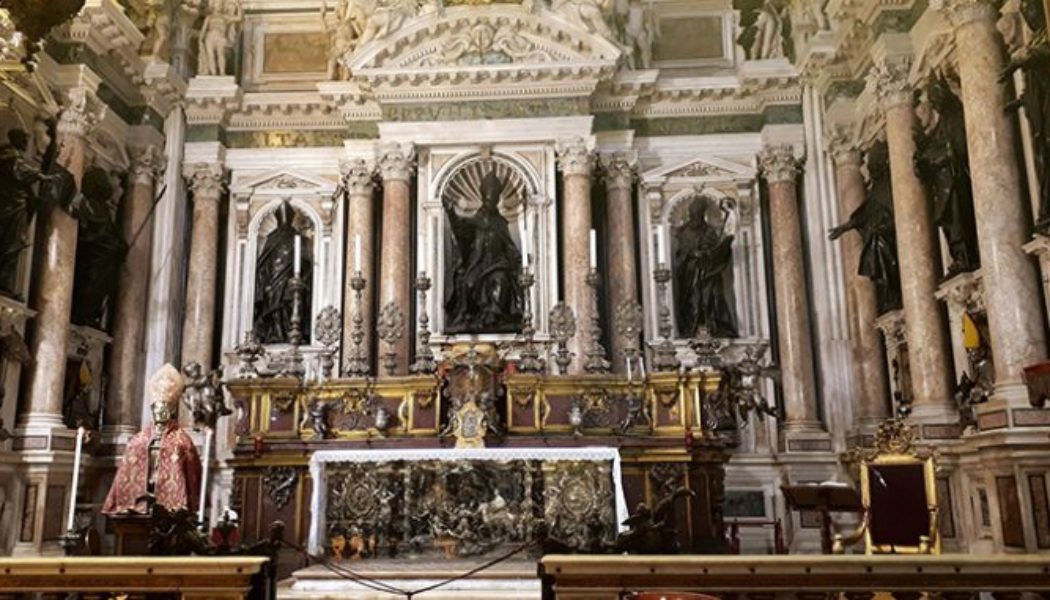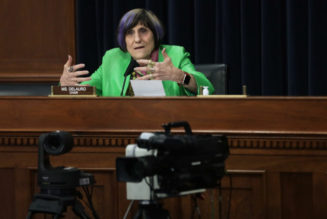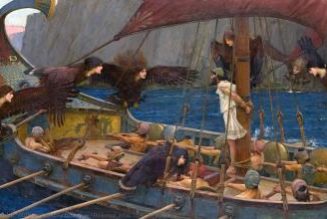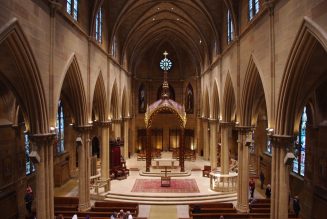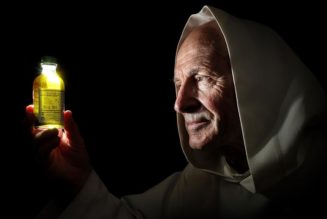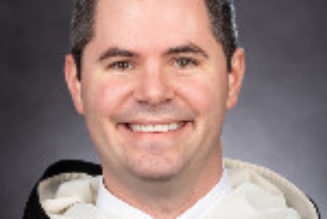
As the Church marked the beginning of Advent with the lighting of the Hope candle, a series of extraordinary events unfolded, capturing the attention of the Italian media, including the Orthodox Archdiocese of Italy. A particularly unforeseen event took place in Naples, Italy, during the visit of His All-Holiness Ecumenical Patriarch Bartholomew I. The Patriarch was in Naples from November 22-25 to receive an Honorary Doctorate in Theology from the Pontifical School of Theology of Southern Italy. On the morning of November 23, prior to the conferral of the honorary degree and the Lectio Magistralis, the Patriarch, escorted by local religious leaders, visited the Cathedral of Naples.
In the Cathedral’s Chapel of the Treasury, where the sacred relics of Naples’ patron saint, Januarius (known as San Gennaro in Italian) are housed, a momentous event occurred. Saint Januarius, martyred around 305 A.D. during Emperor Diocletian’s reign, is venerated here, with his relics including two glass ampoules containing his dried blood. When Patriarch Bartholomew I held the relic, the dried blood within the ampoules unexpectedly liquefied. This miraculous occurrence, which remains unexplained by science, is traditionally believed to happen in response to the dedication and prayers of the local Napolitane faithful.
The liquefaction of St. Januarius’ blood is a revered phenomenon, occurring three times annually: on the Saturday before the first Sunday in May, in remembrance of the saint’s relics being moved from Pozzuoli to Naples; on September 19, the feast day of St. Januarius; and on December 16, in commemoration of the miraculous cessation of Mount Vesuvius’ eruption in 1631. The occurrence of this miracle during the Patriarch’s visit may be interpreted as a propitious sign for ecumenical relations.
Setting aside the miraculous events, the Lectio Magistralis delivered by Patriarch Bartholomew I was centered around the theme of “Dialogue and Orthodoxy”, reinforcing the Patriarch’s dedication to ecumenism, particularly with the Catholic Church. This commitment was highlighted by his advocacy for a potential shared Eucharistic meal. Presenting his lecture in Italian, the Ecumenical Patriarch elaborated on strategies to cultivate visible Christian unity between the Eastern and Western churches, a cornerstone of his role as the Ecumenical Patriarch.
The insights offered by the Patriarch instill hope for the possibility of achieving Christian unity sooner than anticipated. This aspiration could potentially align with the celebration of two significant anniversaries: the 1,700th anniversary of the Council of Nicaea (A.D. 325) and the 60th anniversary of the historic meeting between Pope Paul VI and Patriarch Athenagoras on the Mount of Olives in Jerusalem on January 6, 1964. The embrace shared by these two leaders in 1964 was more than symbolic; it was prophetic. The subsequent year, on December 7, 1965, through joint declaration, they announced the revocation of the mutual excommunications that had been pronounced in 1054. Their visionary leadership and intuitive understanding of the critical need for Christian unity fortified the commitment to ecumenism made during the Second Vatican Council. These historical events and anniversaries serve as a call to all Christians to recognize that the bonds uniting us surpass those that divide us. The pursuit of unity among Christians and a collective approach to addressing contemporary global issues reflect not merely the demands of our time but also the mandates set forth by Jesus Christ, the Founder of the Church. These significant milestones in Christian history serve as poignant reminders of this enduring truth.
In his Lectio Magistralis, Patriarch Bartholomew I delved into several key topics, primarily focusing on historical memory–examining significant events in the history of the undivided Church and advocating for a purification of memory. He emphasized that the shared Christian history, founded on the pillars of Scripture, Tradition, and Patristic authority, is pivotal in fostering a reinvigorated commitment to the ecumenical movement and promoting unity between the Eastern and Western Churches.
The Patriarch reflected on the historical separation between the Eastern and Western Churches, suggesting that this divide stemmed not solely from theological or ecclesiastical differences but also from cultural and political factors. This perspective aligns with the recently approved document on Synodality and Primacy in the Second Millennium and Today (Alexandria June 7, 2023). This document underscores a collective understanding of history and calls for a purification of memory concerning the second Christian millennium.
Patriarch Bartholomew highlighted the role of differing modes of thought and often non-inclusive languages in causing divisions within the Church. This observation parallels the concerns addressed by Apostle Paul in his epistle to the Corinthians, where he aimed to resolve cultural and spiritual challenges that threatened the early Church’s stability:
Each of you is saying, “I belong to Paul,” or “I belong to Apollos,” or “I belong to Cephas,” or “I belong to Christ.” Is Christ divided? Was Paul crucified for you? Or were you baptized in the name of Paul? (1 Corinthians 12-13)
Through his analysis, Patriarch Bartholomew underscored the significance of recognizing and reconciling these historical divergences in order to advance unity within the Christian Faith. He astutely notes that a sequence of estrangements often begets further divisions, weakening the potency of the Christian-evangelical message and the proclamation of the Gospel. However, he offers a perspective of hope, employing the metaphor of a mosaic. He posits that even if a single stone in a mosaic becomes damaged or deteriorates, thereby affecting the overall image (symbolizing aspects such as Writing, Eucharist, Church), this stone nonetheless remains an integral part of the entire mosaic:
… the Communities that arose after the Councils of Ephesus and Chalcedon, even in schism or heresy, they continue to form the consciousness of being part of the one and the same mosaic. In other words, division, schism, or heresy, – even if they deprive of communion, do not deprive one of belonging to the one-united Church of Christ, just as a disease of an organ of the body does not make the organ itself foreign to the body.
This analogy underscores the enduring connection and relevance of each member Church within the broader context of Christian unity.
Essentially, the Patriarch’s message conveys that the unfortunate divisions within Christianity do not negate our membership in the indivisible body of Christ. Human limitations, characterized by sinfulness and fractured relationships within ecclesial communion and the wider world, are the root causes of these divisions. However, the Church, as a sacramental communion, remains holy and indivisible. This understanding fosters a sense of ecumenical hope.
A complex issue addressed in the Patriarch’s Lectio Magistralis is uniatism, which he describes as “the theory of the return” to the Latin/Roman fold by the Eastern Orthodox faithful. This approach to unity, as highlighted by the Patriarch, has been a source of significant strife, contributing to some of the most challenging and painful chapters in the relations between the Eastern and Western Churches, particularly marking the ecclesiastical history of the second millennium.
Additionally, the Patriarch emphasized significant ecumenical developments of the twentieth century, particularly highlighting the historic Patriarchal Encyclicals of 1902 and 1920. These documents were instrumental in guiding the Ecumenical Movement and contributed to the formation of the World Council of Churches (WCC). He also paid tribute to his predecessor Patriarch Athenagoras (1948-1972), whom Bartholomew described as both a visionary and a prophet of the dialogue of love. Underlining the proactive steps taken by Patriarch Athenagoras, Bartholomew noted that soon after his enthronement, Athenagoras initiated the preparations for a Synod of the Orthodox Church by organizing a series of Pan-Orthodox Conferences.
The concluding section of the address, titled “A New Beginning,” concentrated on specific endeavors and initiatives by the Ecumenical Patriarchate over the 32 years following Patriarch Bartholomew’s ascension to the Patriarchal Throne of Constantinople in 1991. These efforts were aimed at fostering Christian unity. In his address, Patriarch Bartholomew delineated four fundamental principles guiding these efforts: The visible unity of the Orthodox Church; dialogue and cooperation with all Christian Churches; engagement and collaboration with world religions, particularly Judaism and Islam; the promotion of justice, peace, unity of humanity; and the safeguarding of creation. Patriarch Bartholomew highlighted his presence at the enthronement of Pope Francis, the Bishop of Rome, noting their shared values and steadfast commitment to achieving full communion. This objective aligns with the goal set in 1979 through the Common Declaration of Pope John Paul II and the Ecumenical Patriarch Dimitrios:
…we affirm once again our firm desire to do everything possible to hasten the day when full communion will be restored between the Catholic Church and the Orthodox Church and when we will finally be able to concelebrate the Eucharist.
The Patriarch explicates that the only path toward unity is through honest dialogue. He asserts that the primary threat to the Church’s testimony is not its openness and engagement in dialogue, but rather its tendencies towards closure and self-absorption. This perspective was further confirmed by the Patriarch in a recent interview with the Italian publication Avvenire, where he reaffirmed this approach as the roadmap to Christian unity:
… There is no other way to move towards unity than through honest dialogue. In my opinion what threatens the Church’s testimony is not openness and dialogue, but closure and introversion. For the Orthodox Church, the general purpose of ecumenical dialogues has been clearly defined by the Holy and Great Council: ‘It is clear that in theological dialogues the common goal of all is the final restoration of unity in true faith and love.’ The Orthodox Church, through its participation in ecumenical dialogues, has never accepted a compromise on matters of faith. Unity, which is founded on Truth, is and remains desired.
The Patriarch’s Lectio Magistralis not only echoed his previous statements but also reinforced his actions towards achieving complete Christian unity between the Catholic and the Orthodox Churches. However, a prevailing question remains: When will full Eucharistic unity between the Orthodox and Catholic Churches be realized? This query, frequently raised by various audiences, continues to stimulate widespread interest and discussion. My stance is one of optimism—such unity may be attained sooner than we anticipate. The pursuit of unity is a collaborative effort—humanity strives, and it is God who blesses and perfects these endeavors. As the Patriarch mentioned in his recent interview with Avvenire, the future, including our commitment to unity, ultimately rests in God’s hands. Nevertheless, it remains imperative that we persist in doing all that is humanly achievable in this pursuit.
The unexpected liquefaction of San Januarius’s blood in the hands of the Ecumenical Patriarch of Constantinople could be interpreted as an auspicious omen for ecumenical unity between East and West. In this Advent season, our aspirations should extend beyond mere hope; we should cultivate an ecumenical hope—is a hope that transcends divisions and fosters authentic unity among Christians.
If you value the news and views Catholic World Report provides, please consider donating to support our efforts. Your contribution will help us continue to make CWR available to all readers worldwide for free, without a subscription. Thank you for your generosity!
Click here for more information on donating to CWR. Click here to sign up for our newsletter.
